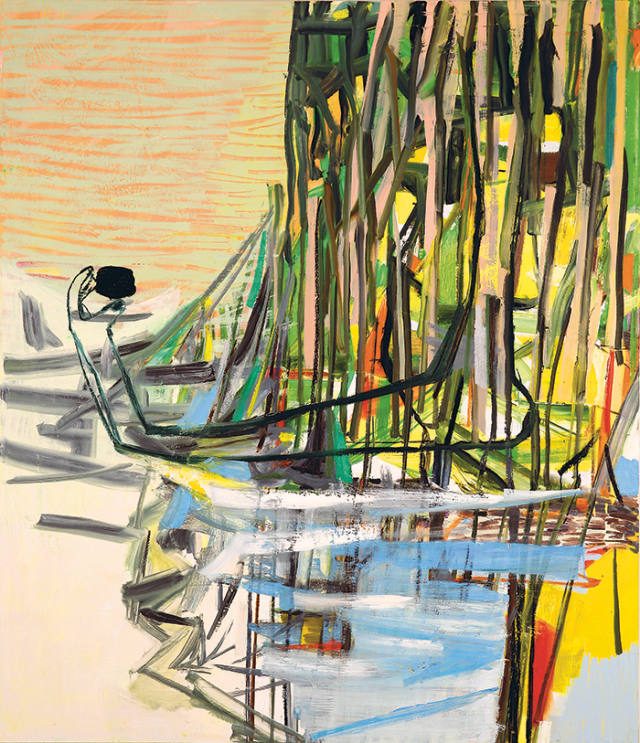 Amy Sillman, Get the Moon (detail), 2006, oil on canvas, 80" x 69". Courtesy of Sikkema Jenkins & Co., New York.
Amy Sillman, Get the Moon (detail), 2006, oil on canvas, 80" x 69". Courtesy of Sikkema Jenkins & Co., New York.
Amy Sillman and Tom McGrath are very different kinds of New York artists—Amy a modern-day action painter, Tom a new breed of realist—who share an ontological approach to the problem of pictorial staging: What is this thing I am making, they ask, and how can it be said to “represent” anything other than itself? Tom uses creamy, wet paint applied with directness and brio to depict more or less real places; Amy’s paintings, though populated with figures and figurative gestures, use the canvas as a workshop in which eccentrically shaped blocks of color are cobbled together in a kind of improvisational architecture, like memories of houses that you never actually lived in. Amy comes to us by way of abstraction, and over the past decade has been completely refurbishing the formal elements of painting: color, line, shape, and texture. Tom, a younger, cerebral artist, has established himself as an innovator by painting something that had not previously been considered a subject for art—the world viewed through the windshield of a car.
What makes a “picture”? Is every painting pictorial, or is it a quality of only some paintings? I think it is chiefly a matter of how forcefully a painting evokes the strangeness of the notion of a depicted visual world—the set of arrangements that results in something being pictured. Both Amy and Tom, using very different orchestration, make this pictorial staging palpable by calibrating three elements: the thing painted; the frame of reference, the rectangle; and the way the paint comes to rest on the canvas.
Untitled (Wal-Mart) and Untitled (Wiper Fluid) depict the experience of looking out at a landscape through a wet windshield—an original pictorial invention, this alignment of the canvas with the frame of the windshield, that like many great ideas arrives with a feeling of déjà vu attached. How has no one thought of this before? Toms paintings capture the ennui of traveling through a banal roadside landscape, that sense of entrapment one has driving the interstate. The landscapes are devoid of sentimentality and grandeur; they are functional, postindustrial, and antiromantic. But I think they chase bigger game: In Tom’s paintings the visible world is often melty-looking, insubstantial and extemporaneous, waterlogged, greasy, and unfinished. It is this lack of solidity, the painterly malleability of the too-familiar world, that is their true subject.
Sometimes Tom paints the outside of a car, usually one that has crashed. Others have made paintings of cars as objects, but no one except Warhol has painted wrecked cars (and even he can’t, properly speaking, be said to have actually painted them). The formal complexity of Untitled (Car Crash)—all that zigzaggy metal!—is a bracing solution to the challenge of finding a painterly equivalent for the violently crumpled form. It’s a kind of late-industrial twist on painting fundamentals: Where the plane changes, the color changes. A later work, Blue Ridge by Headlights, is a similarly efficient pictorial innovation, involving the alignment of brush effects with the way black trees at night “jump up” white when discovered by headlights—and the effect is accomplished with such spontaneity that it does not feel literal, but like a poetic equivalent.
Amy Sillman combines great lyricism with psychological scrutiny in all her paintings. But she works in two dominant modes, each of which derives from the kind of tools she uses: One involves all manner of marks, from slapping to fanning to pointed drawing, made with traditional brushes; the other is achieved by scraping and dragging and drawing with a palette knife and soft oil-stick crayons. The range is from the fortresslike solidity of Purple Thing to the fluttering, kitelike airiness of My Pirate. Amy’s “solid” paintings are built from drawing, and the line in them is strong indeed; the structure, too, is remarkably self-assured, like a ship that has been reconfigured and repainted but still retains all the original rivets and portholes. These paintings are not built for speed but for durability on the long voyage.
Yet Amy’s paintings are never heavy, the hulking, buttressed forms leavened with drawing of great ingenuity and immediacy, and they don’t shy from the anecdotal “a funny thing happened” feeling of life. Amy has the most assertive and surprising sense of color of any painter working today; it gives her paintings buoyancy and also contributes to their humor. In some of her paintings, an arm emerges from an accumulation of planes and geometric forms, of blunt and flat brush strokes, to offer up an object: Look at this! That repeated gesture, which borrows from the goofy, self-deprecating world of cartoons, goes right to the heart of our pictorial mystery—the painting is showing us something, how generous! These agile works, which might be called her aviary paintings, are built from a procession of shapes with the lilting, fluttering quality of banners and flags in the wind. The shapes themselves are the result of an arching, wrist-inflected brush mark, with an upward finish like the point of a falling leaf. These paintings are lighter than the “solid” works and more elusive, evoking, in place of architecture, dreams of flight—the sense of elation, of danger somehow temporarily averted.
—David Salle
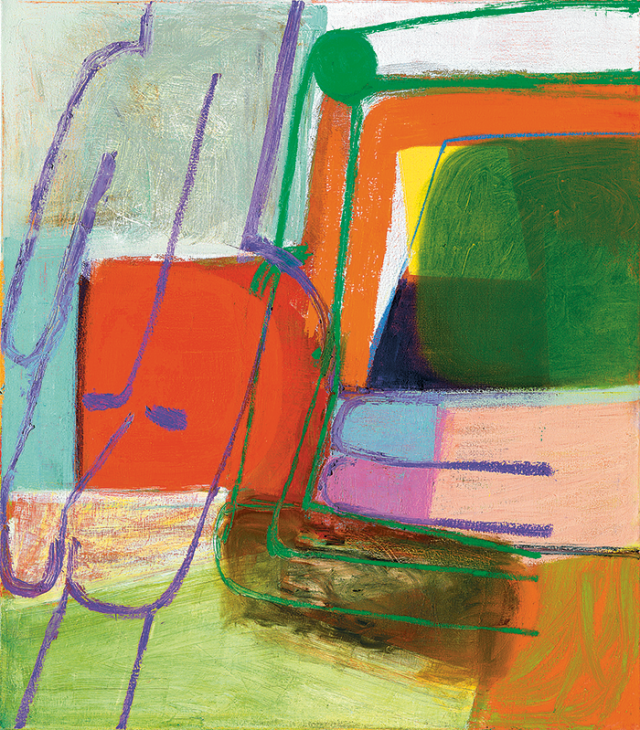 Amy Sillman, Untitled (Finger), 2009, oil on canvas, 51 ⅕" x 45 ¼". Courtesy of Sikkema Jenkins & Co., New York.
Amy Sillman, Untitled (Finger), 2009, oil on canvas, 51 ⅕" x 45 ¼". Courtesy of Sikkema Jenkins & Co., New York.
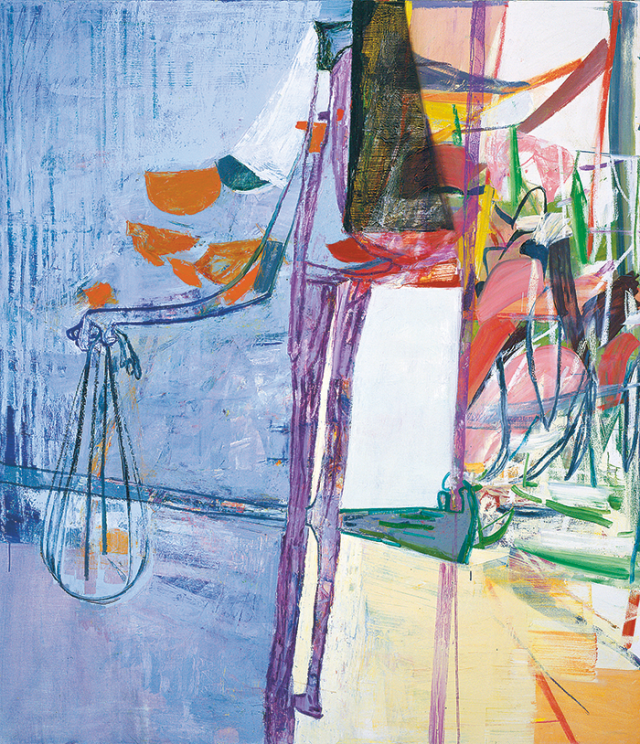 Amy Sillman, The Plumbing, 2006, oil on canvas, 80" x 69". Courtesy of Sikkema Jenkins & Co., New York.
Amy Sillman, The Plumbing, 2006, oil on canvas, 80" x 69". Courtesy of Sikkema Jenkins & Co., New York.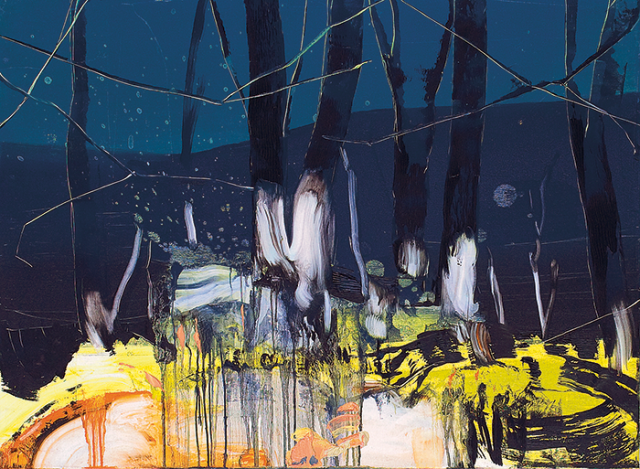 Tom McGrath, Blue Ridge by Headlights, 2009, oil on canvas over panel, 22" x 30". Courtesy of Sue Scott Gallery, New York.
Tom McGrath, Blue Ridge by Headlights, 2009, oil on canvas over panel, 22" x 30". Courtesy of Sue Scott Gallery, New York.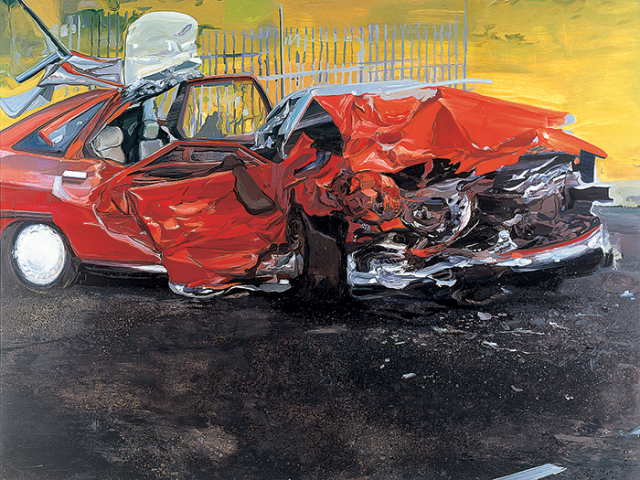 Tom McGrath, Untitled (Car Crash), 2004, oil on canvas, 72" x 96". Courtesy of Sue Scott Gallery, New York.
Tom McGrath, Untitled (Car Crash), 2004, oil on canvas, 72" x 96". Courtesy of Sue Scott Gallery, New York.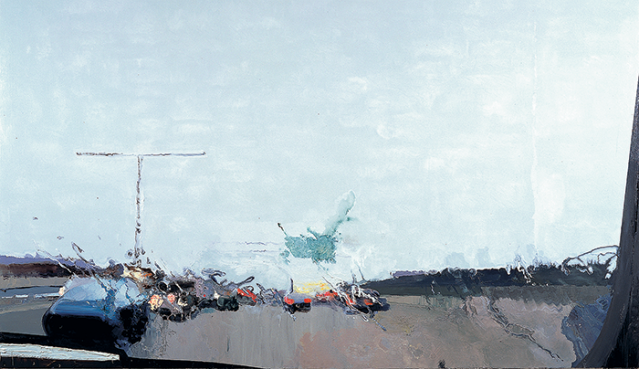 Tom McGrath, Untitled (Wiper Fluid), 2002, oil on canvas, 60" x 96". Courtesy of Sue Scott Gallery, New York.
Tom McGrath, Untitled (Wiper Fluid), 2002, oil on canvas, 60" x 96". Courtesy of Sue Scott Gallery, New York.



